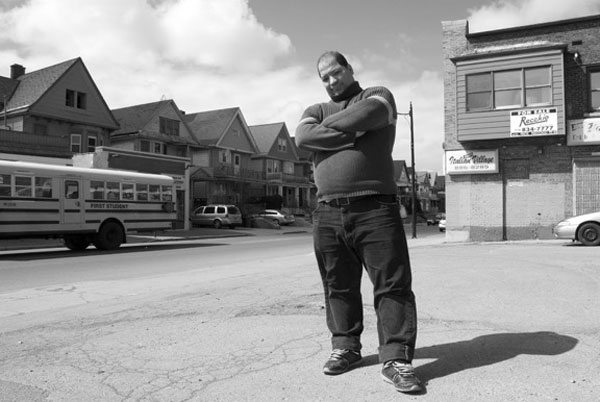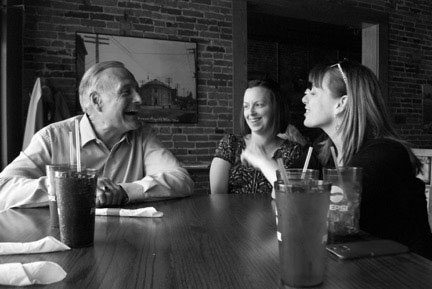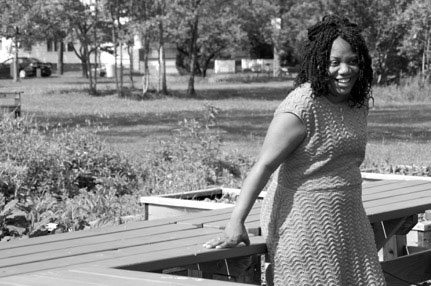
This article is the latest installment in the Equity, Diversity, and Inclusion Series co-sponsored by YNPN and NPQ.
Far too many young people in the United States today are growing up without tangible examples of people impacted by a problem having the opportunity to shape their own reality. A teenager in a rural community could feel this absence after the town’s lone employer, which long provided the power and leadership to look after the basic needs of most people, shutters its doors, and no one knows quite how to fill its shoes. For a teenager growing up in an urban Rust Belt neighborhood, it could be because for decades her community was redlined, and power was, and still is, systematically denied.
When young people grow up believing that power and leadership are inaccessible and beyond what they can associate with their identity, their potential and future plans can be encumbered. This in turn throws the future of their communities into peril. In today’s world—perhaps more so than at any other time in recent history—the future of places big and small will not be determined by a singular leader or multinational corporation but rather by the people who live there.
We believe that knowing how to shape your own reality—be it individually in professional or personal matters, or together as communities—should be a core part of young people’s education. With that knowledge, they will be better equipped to navigate their own futures as well as participate in shaping the future of the place they call home. This belief, however, begs the questions: What does it look like for a community to own its own future? What do the people who make up a community need to know and be able to do?
In 2014, we founded Why We Work Here (WWWH) and embarked on a year of research to observe, record, and analyze what it looks like when various place-based groups seek not just to “fix” problems head on but also to make problem solving an inclusive, community-driven process, wherein power and leadership are shared. We selected six groups to look at across the country, representing a range of sectors (nonprofit, private, and philanthropic) and issue areas (economic development, environmental sustainability, education, housing). Each group distinguished itself in how it saw its role in and relationship to its community, and the degree to which it controlled decision-making processes. All saw measurable, positive, equitable change ensue from their efforts. We wanted to know: How do they do what they do? What do they believe? And, technical skills aside, what do they know how to do?
We discovered that, despite hailing from different sectors and geographical locations, the approaches used by these organizations have strong common threads, including:
- Leadership development and capacity building. The groups recognize that supporting self-aware, empathetic, and action-oriented residents capable of working collaboratively across differences is critical for change to be transformative and enduring. Specific projects or efforts are vehicles for ongoing capacity building as much as they are about project-specific outcomes.
- Building a foundation of trust. The groups prioritize the development and sustenance of trusting relationships, both between them and the greater community and among community members. They do this through supporting diverse constituencies by identifying common values, being transparent in their own decision making and operations, and delivering on their word.
- Shared vision. The groups recognize the value of “looking at the same picture,” and work to ensure that stakeholders are a part of the development and execution of a shared vision.
These tenets, along with the specific skills and mindsets we identified through our research as essential to the groups’ effectiveness, are the inspiration and underpinnings for WWWH’s current work with educators and high school students. Through real, project-based experiences that are contextualized in the community, we support young people to recognize their own agency in shaping both individual and community-wide outcomes, and equip them with the skills to act with courage. We work closely with educators so that they can lead these programs and integrate skill-building activities into the regular school day.
We would like to share the stories of three of the groups we researched in the hope that tangible examples can help others imagine how their own actions could support alternative futures for their own communities.1
Incourage Community Foundation

Incourage is a community foundation that’s fostering a participatory culture whereby residents are shaping a renewed, inclusive economy in south Wood County, Wisconsin.
For much of the twentieth century, the regional economy of south Wood County was dominated by the paper industry and flush with stable jobs that allowed most people to live comfortably. In 1999, however, Consolidated Papers, Inc.—a Fortune 500 company headquartered there—announced that it was cutting seven hundred jobs, and the following year it was sold to a foreign company. By 2005, total employment in the county had been cut by 40 percent.2 The sudden loss of this economic anchor heightened social divisions and the sense of hopelessness throughout the community, and resulted in the loss of a shared identity.3
The collapse was a wake-up call for Incourage—then the Community Foundation of Greater South Wood County—which at the time operated the same way as many community foundations: it reacted to the needs of the community. Its board and staff began reexamining the foundation’s role toward helping the region heal and regenerate a local economy. Their belief was that upward, lasting change would be possible if residents could develop the enduring confidence and competencies to envision and implement community-wide transformation.
In the past decade, Incourage has invested in efforts that are laying the groundwork for a new culture of collective self-determination locally, including their most ambitious project yet—the community-led redevelopment of the Tribune Building, once the home of the local newspaper. Incourage purchased the abandoned building in 2012, and since then it has facilitated a process for the community to direct the building’s redevelopment and programming.4
As anyone involved will tell you, this was about more than a building. At its core, the Tribune is a vehicle for building relationships based on mutual interests and hopes, for establishing new skills and ways to collaborate constructively, and for rebuilding a collective sense of confidence to act proactively. Regular meetings begin with a discussion of what progress has been made to date and how the current evening’s activities will influence the development process. Community members—usually several hundred in attendance—work in groups around a programmatic component of shared interest: the microbrewery, the kitchen incubator, the children’s spaces. Groups are led by community members who are trained facilitators.
While the Tribune process itself encourages new expectations, behaviors, and mindsets in participants, it also builds off of previous efforts investing in adaptive leadership skill development and building partnerships to support a stronger local economy. “What we’re seeing now wouldn’t have been possible previously,” an Incourage staff member explained, referencing the way participants are coming together to hear one another and collaborate and recognizing the value and potential of their own ideas.
Sign up for our free newsletters
Subscribe to NPQ's newsletters to have our top stories delivered directly to your inbox.
By signing up, you agree to our privacy policy and terms of use, and to receive messages from NPQ and our partners.
Saint Paul Federation of Teachers5

The Saint Paul Federation of Teachers (SPFT) is a teachers union that has evolved its priorities and built stronger relationships with parents in order to support the development of “the school system Saint Paul students deserve”(one of SPFT’s main rallying cries). Nationally, the dialogue about the problems with U.S. schools often focuses on the deficits of teachers and the ineffectiveness of teachers unions. This story was playing out in Saint Paul, Minnesota, as well, and many teachers felt deeply discouraged by the divisive climate and narrative that excluded the voices of the people at the heart of the matter: teachers, parents, and students.
SPFT functioned for many years like a traditional union: members paid dues, and contract negotiations centered on pay and benefits. In 2005, in light of the heightened debate about education and teachers, the union’s new leadership saw an urgent need to rethink the role and strategy of the union in order to better support teachers and respond to the real needs of schools and students.
Since then, SPFT has transformed its organization in a number of ways—including, most emblematically, its approach to contract negotiations. Arguably one of the biggest tools a union has to turn a vision into reality, SPFT uses the process of developing its negotiation document as an opportunity to build a shared vision for the district that’s grounded in the needs of students, parents, and teachers.
During this process leading up to its 2013 negotiations, SPFT engaged teachers and parents in a series of listening sessions. They discussed three questions: “What are the schools Saint Paul children deserve?”; “Who are the teachers Saint Paul children deserve?”; and “What is the profession those teachers deserve?”6 What they came up with was a bold, constructive vision that became a guide for the union’s negotiations. Just as important, teachers and parents saw each other as allies who ultimately wanted the same opportunities and outcomes for children and wanted to support one another to achieve their shared goals.
While most collective bargaining sessions remain closed, SPFT opened its sessions to the public. Because of SPFT’s consistent and deep investment in teachers and parents up to this point, throngs of people filled the negotiating room as conversations heated up. Union members and parents went door to door and rallied outside in the depth of winter. Parents created their own Facebook pages to better organize themselves in support of their students’ schools and teachers. Ultimately, the school board agreed to negotiate on every point they presented, which included smaller class sizes, less standardized testing, and the hiring of additional librarians, nurses, social workers, and counselors.
Today, more teachers are joining the union and more parents are getting involved in ways ranging from running for the school board to becoming trainers for the Parent Teacher Home Visits.7 In a move to support leadership development for both teachers and parents, SPFT employs two full-time organizers, who support long-term constructive strategies and focus on matching people’s interests and availability with opportunities to get involved.
People United for Sustainable Housing

People United for Sustainable Housing (PUSH) in Buffalo, New York, is a member-driven organization that combines community development and organizing to address Buffalo’s West Side residents’ needs and build greater community control of resources.
Buffalo’s West Side is a poor neighborhood in one of the nation’s poorest cities, and has suffered from decades of disinvestment. Yet the neighborhood has a rich cultural legacy, and today it’s more diverse than ever. Its affordability allows many to build new lives—including refugees from Burma, Somalia, and other countries beset by conflict—yet because it borders a rapidly gentrifying neighborhood, the West Side’s affordability is being jeopardized as property values rise.
PUSH began, humbly, in 2005, when its cofounders went door-to-door listening to issues voiced by residents. Jennifer Mecozzi, PUSH’s organizing director (now its logistics coordinator), was one such resident. “[One of the founders] came to my house one day and asked all these questions…. He didn’t write anything down, but he must have really written a book after he left. He came back about three months later…and he brought up everything I had talked about. I was totally impressed…so I thought, ‘Well, you took the time to do this, so I’ll go to a meeting.’”8
Based on what the founders heard—that vacant and substandard housing was a major problem for many—they began rehabbing a house in the neighborhood. Many service providers had previously entered and exited the neighborhood, and many residents had grown accustomed to and skeptical of newcomers promising support and solutions. PUSH quickly set itself apart from its predecessors by being action oriented, responsive, and accountable to the conversations staff had with residents.
Today, PUSH is building a self-supporting ecosystem in the West Side neighborhood: it builds housing for sale and rent; provides energy-efficiency retrofits; develops urban gardens and storm-water management infrastructures; manages green economy and construction crews who hire locally and pay living wages; and runs an afterschool program for neighborhood youth. The ideas that become campaigns or programs come from residents through many avenues, including annual community congresses, regularly convening working groups, and conversations community members and PUSH staff have that happen organically.9
PUSH’s focus on building human capital every step of the way gives this ecosystem durability and power. The success of its capacity building and leadership-development efforts relies on first addressing the most basic, unmet needs of residents (housing, employment) and then supporting individuals to participate more deeply in actions that support their community’s shared future.
…
These groups recognize that making inclusive, community-driven processes the norm and sharing power and leadership calls for a cultural transformation that takes a long time to evolve, necessitates immense patience and thoughtfulness, and requires an appetite for risk and for practices atypical of their sector. Their investments are paying off, however, and we hope that their pioneering efforts will serve as examples that will help other organizations, regardless of sector, issue area, or geography, to facilitate deep cultural transformation in their own communities.
Notes
- The stories are from interviews conducted by the authors over a four-month period in 2015, and from the organization’s websites and/or other supplemental materials.
- Judith Millesen and Kelly Ryan, “Community Foundation Leadership in the Second Century: Adaptive and Agile,” from Here For Good: Community Foundations and the Challenges of the 21st Century, Terry Mazany and David C. Perr (New York: Routledge, 2014).
- Ibid.
- “Tribune: Our Community Accelerator,” Incourage Community Foundation website, August 31, 2015.
- All information in this section was taken from Eric S. Fought, Power of Community: Organizing for the schools St. Paul children deserve (St. Paul, MN: Federation of Teachers, 2014).
- Fought, Power of Community, 11.
- “Parent Teacher Home Visits,” Saint Paul Federation of Teachers website, accessed November 7, 2015.
- From an interview with the authors, October 2014.
- “About Us,” PUSH Buffalo website, accessed November 7, 2015.









